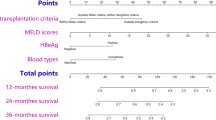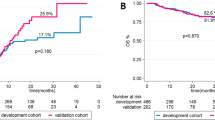Abstract
Hepatocellular carcinoma (HCC) is one of the most prevalent malignant tumors worldwide. Liver transplantation (LT) is known as a curative and therapeutic modality. However, the survival rates of recipients after LT are still not good enough because of tumor recurrence. To improve the survival rates of recipients after LT, identifying predictive factors for prognosis after LT and establishing a model assessing prognosis are very important to HCC patients. There has recently been a lot of clinical and basic research on recurrence and prognosis after LT. Progress has been made, especially in selection criteria for LT recipients and risk factors for predicting prognosis after LT. Hangzhou criteria, in line with China’s high current incidence rate of primary liver, are first proposed by Chinese scholars of LT, and are accepted world-wide, and make an important contribution to the development of LT.
中文概要
研究肝癌肝移植患者术后生存与影响生存的各影 响因素之间的关系,并评价各影响因素及移植标 准的价值。筛选有效的预测肝癌预后的影响因 素,可帮助建立肝移植术后肿瘤预后预警机制, 对改善肝癌肝移植受体的术后预后具有重要意 义。杭州标准是被国际移植学界广泛接受的肝癌 肝移植标准,在引领肝癌肝移植领域的发展中做 出了重要贡献。
Similar content being viewed by others
References
Agopian VG, Harlander-Locke M, Zarrinpar A, et al., 2015. A novel prognostic nomogram accurately predicts hepatocellular carcinoma recurrence after liver transplantation: analysis of 865 consecutive liver transplant recipients. J Am Coll Surg, 220(4):416–427. https://doi.org/10.1016/j.jamcollsurg.2014.12.025
Ahn CS, Moon DB, Lee SG, et al., 2014. Survival differences between Milan criteria after down-staging and De novo Milan in living donor liver transplantation for hepatocellular carcinoma. Hepatogastroenterology, 61(129): 187–191.
Akoad ME, Pomfret EA, 2015. Surgical resection and liver transplantation for hepatocellular carcinoma. Clin Liver Dis, 19(2):381–399. https://doi.org/10.1016/j.cld.2015.01.007
Audet M, Panaro F, Piardi T, et al., 2009. Are the Hangzhou criteria adaptable to hepatocellular carcinoma patients for liver transplantation in Western countries? Liver Transpl, 15(7):822–823. https://doi.org/10.1002/lt.21765
Balogh J, Victor D 3rd, Asham EH, et al., 2016. Hepatocellular carcinoma: a review. J. Hepatocell Carcinoma, 3:41–53. https://doi.org/10.2147/JHC.S61146
Chan SC, 2013. Liver transplantation for hepatocellular carcinoma. Liver Cancer, 2(3-4):338–344. https://doi.org/10.1159/000343849
Ciccarelli O, Lai Q, Goffette P, et al., 2012. Liver transplantation for hepatocellular cancer: UCL experience in 137 adult cirrhotic recipients. Alpha-foetoprotein level and locoregional treatment as refined selection criteria. Transpl Int, 25(8):867–875. https://doi.org/10.1111/j.1432-2277.2012.01512.x
Duvoux C, Roudot-Thoraval F, Decaens T, et al., 2012. Liver transplantation for hepatocellular carcinoma: a model including α-fetoprotein improves the performance of Milan criteria. Gastroenterology, 143(4):986–994.e3. https://doi.org/10.1053/j.gastro.2012.05.052
Fan ST, 2008. Selection of HCC patients for liver transplantation: the Milan criteria, Hangzhou criteria and beyond. Hepatobiliary Pancreat Dis Int, 7(3):233–234.
Ferreira MV, Chaib E, Nascimento MU, et al., 2012. Liver transplantation and expanded Milan criteria: does it really work? Arq Gastroentero, 49(3):189–194. https://doi.org/10.1590/S0004-28032012000300004
Grąt M, Kornasiewicz O, Lewandowski Z, et al., 2014. Combination of morphologic criteria and α-fetoprotein in selection of patients with hepatocellular carcinoma for liver transplantation minimizes the problem of posttransplant tumor recurrence. World J Surg, 38(10):2698–2707. https://doi.org/10.1007/s00268-014-2647-3
Guerrini GP, Pinelli D, di Benedetto F, et al., 2015. Predictive value of nodule size and differentiation in HCC recurrence after liver transplantation. Surg Oncol, 25(4): 419–428. https://doi.org/10.1016/j.suronc.2015.09.003
Gugenheim J, Bredt LC, Iannelli A, et al., 2013. Recurrence after liver transplantation for hepatocellular carcinoma according to up-to-seven criteria. Hepatogastroenterology, 60(124):799–806. https://doi.org/10.5754/hge12997
Guo R, Feng X, Xiao S, et al., 2015. Short- and long-term outcomes of hepatectomy with or without radiofrequencyassist for the treatment of hepatocellular carcinomas: a retrospective comparative cohort study. Biosci Trends, 9(1):65–72. https://doi.org/10.5582/bst.2014.01142
Hameed B, Mehta N, Sapisochin G, et al., 2014. Alphafetoprotein gt;1000 ng/ml as an exclusion criterion for liver transplantation in patients with hepatocellular carcinoma meeting Milan criteria. Liver Transpl, 20(8):945–951. https://doi.org/10.1002/lt.23904
Hirokawa F, Hayashi M, Miyamoto Y, et al., 2015. Predictors of poor prognosis by recurrence patterns after curative hepatectomy for hepatocellular carcinoma in Child-Pugh classification A. Hepatogastroenterology, 62(137):164–168.
Ioannou GN, Perkins JD, Carithers RL, 2008. Liver transplantation for hepatocellular carcinoma: impact of the MELD allocation system and predictors of survival. Gastroenterology, 134(5):1342–1351. https://doi.org/10.1053/j.gastro.2008.02.013
Kanai T, Hirohashi S, Upton MP, et al., 1987. Pathology of small hepatocellular carcinoma. A proposal for a new gross classification. Cancer, 60(4):810–819. https://doi.org/10.1002/1097-0142(19870815)60:4lt;810:: AID-CNCR2820600417gt;3.0.CO;2-1
Kashkoush S, El Moghazy W, Kawahara T, et al., 2014. Three-dimensional tumor volume and serum alphafetoprotein are predictors of hepatocellular carcinoma recurrence after liver transplantation: refined selection criteria. Clin Transplant, 28(6):728–736. https://doi.org/10.1111/ctr.12373
Kim H, Park MS, Park YN, et al., 2009. Preoperative radiologic and postoperative pathologic risk factors for early intra-hepatic recurrence in hepatocellular carcinoma patients who underwent curative resection. Yonsei Med J, 50(6):789–795.
Kim JH, Sinn DH, Gwak GY, et al., 2016. Factors determining long-term outcomes of hepatocellular carcinoma within the Milan criteria: liver transplantation versus locoregional therapy: a retrospective cohort study. Medicine (Baltimore), 95(35):e4735. https://doi.org/10.1097/MD.0000000000004735
Kumaran V, 2014. Role of liver transplantation for hepatocellular carcinoma. J Clin Exp Hepatol, 4(Suppl 3):S97–S103. https://doi.org/10.1016/j.jceh.2014.01.002
Kwon CH, Kim DJ, Han YS, et al., 2007. HCC in living donor liver transplantation: can we expand the Milan criteria? Dig Dis, 25(4):313–319. https://doi.org/10.1159/000106911
Lai Q, Avolio AW, Manzia TM, et al., 2011. Role of alphafetoprotein in selection of recipients with hepatocellular carcinoma waiting for liver transplantation: must we reconsider it? Int J Biol Markers, 26(3):153–159. https://doi.org/10.5301/JBM.2011.8557
Lai Q, Avolio AW, Manzia TM, et al., 2012. Combination of biological and morphological parameters for the selection of recipients with hepatocellular carcinoma waiting for liver transplantation. Clin Transplant, 26(2):E125–E131. https://doi.org/10.1111/j.1399-0012.2011.01572.x
Lee KW, Yi NJ, Suh KS, 2014. Section 5. Further expanding the criteria for HCC in living donor liver transplantation: when not to transplant: SNUH experience. Transplantation, 97(Suppl 8):S20–S23. https://doi.org/10.1097/01.tp.0000446269.20934.d3
Lei JY, Wang WT, Yan LN, 2013. Up-to-seven criteria for hepatocellular carcinoma liver transplantation: a single center analysis. World J Gastroenterol, 19(36):6077–6083. https://doi.org/10.3748/wjg.v19.i36.6077
Li Z, Zhao X, Jiang P, et al., 2016. HBV is a risk factor for poor patient prognosis after curative resection of hepatocellular carcinoma: a retrospective case-control study. Medicine (Baltimore), 95(31):e4224. https://doi.org/10.1097/MD.0000000000004224
Mazzaferro V, Regalia E, Doci R, et al., 1996. Liver transplantation for the treatment of small hepatocellular carcinomas in patients with cirrhosis. N Engl J Med, 334(11): 693–699. https://doi.org/10.1056/NEJM199603143341104
Mazzaferro V, Llovet JM, Miceli R, et al., 2009. Predicting survival after liver transplantation in patients with hepatocellular carcinoma beyond the Milan criteria: a retrospective, exploratory analysis. Lancet Oncol, 10(1):35–43. https://doi.org/10.1016/S1470-2045(08)70284-5
McHugh PP, Gilbert J, Vera S, et al., 2010. Alpha-fetoprotein and tumor size are associated with microvascular invasion in explanted livers of patients undergoing transplantation with hepatocellular carcinoma. HPB (Oxford), 12(1):56–61. https://doi.org/10.1111/j.1477-2574.2009.00128.x
Merli M, Nicolini G, Gentili F, et al., 2005. Predictive factors of outcome after liver transplantation in patients with cirrhosis and hepatocellular carcinoma. Transpl Proc, 37(6):2535–2540. https://doi.org/10.1016/j.transproceed.2005.06.031
Molmenti PE, Marsh WJ, Dvorchik I, et al., 1999. Hepatobiliary malignancies: primary hepatic malignant neoplasms. Surg Clin North Am, 79(1):43–57. https://doi.org/10.1016/S0039-6109(05)70006-2
Müller V, Fortsch T, Gündelm M, et al., 2013. Long-term outcome of liver transplantation as treatment modality in patients with hepatocellular carcinoma in cirrhosis: a single-center experience. Transplant Proc, 45(5):1957–1960. https://doi.org/10.1016/j.transproceed.2013.01.035
Patel MS, Kohn R, Kratz JR, et al., 2015. The race to liver transplantation: a comparison of patients with and without hepatocellular carcinoma from listing to post transplantation. J Am Coll Surg, 220(6):1001–1007. https://doi.org/10.1016/j.jamcollsurg.2014.12.050
Pawlik TM, Delman KA, Vauthey JN, et al., 2005. Tumor size predicts vascular invasion and histologic grade: implications for selection of surgical treatment for hepatocellular carcinoma. Liver Transpl, 11(9):1086–1092. https://doi.org/10.1002/lt.20472
Reddy SS, Civan JM, 2016. From Child-Pugh to model for end-stage liver disease: deciding who needs a liver transplant. Med Clin North Am, 100(3):449–464. https://doi.org/10.1016/j.mcna.2015.12.002
Silva MF, Sapisochin G, Strasser SI, et al., 2013. Liver resection and transplantation offer similar 5-year survival for Child-Pugh-Turcotte A HCC-patients with a single nodule up to 5 cm: a multicenter, exploratory analysis. Eur J Surg Oncol, 39(4):386–395. https://doi.org/10.1016/j.ejso.2012.12.011
Sohn W, Paik YH, Kim JM, et al., 2014. HBV DNA and HBsAg levels as risk predictors of early and late recurrence after curative resection of HBV-related hepatocellular carcinoma. Ann Surg Oncol, 21(7):2429–2435. https://doi.org/10.1245/s10434-014-3621-x
Toso C, Asthana S, Bigam DL, et al., 2009. Reassessing selection criteria prior to liver transplantation for hepatocellular carcinoma utilizing the scientific registry of transplant recipients database. Hepatology, 49(3):832–838. https://doi.org/10.1002/hep.22693
Varona MA, Soriano A, Aguirre-Jaime A, et al., 2015. Risk factors of hepatocellular carcinoma recurrence after liver transplantation: accuracy of the alpha-fetoprotein model in a single-center experience. Transplant Proc, 47(1): 84–89. https://doi.org/10.1016/j.transproceed.2014.12.013
WHO (World Health Organization), 2016. Hepatitis B. http://www.who.int/mediacentre/factsheets/fs204/en [Accessed on Jan. 28, 2017].
Wong LL, Naugler WE, Schwartz J, et al., 2013. Impact of locoregional therapy and alpha-fetoprotein on outcomes in transplantation for liver cancer: a UNOS Region 6 pooled analysis. Clin Transplant, 27(1):E72–E79. https://doi.org/10.1111/ctr.12056
Xu X, Ke QH, Shao ZX, et al., 2009. The value of serum α-fetoprotein in predicting tumor recurrence after liver transplantation for hepatocellular carcinoma. Dig Dis Sci, 54(2):385–388. https://doi.org/10.1007/s10620-008-0349-0
Xu X, Lu D, Ling Q, et al., 2016. Liver transplantation for hepatocellular carcinoma beyond the Milan criteria. Gut, 65(6):1035–1041. https://doi.org/10.1136/gutjnl-2014-308513
Yang SH, Suh KS, Lee HW, et al., 2007. A revised scoring system utilizing serum alphafetoprotein levels to expand candidates for living donor transplantation in hepatocellular carcinoma. Surgery, 141(5):598–609. https://doi.org/10.1016/j.surg.2006.11.006
Yao FY, Ferrell L, Bass NM, et al., 2001. Liver transplantation for hepatocellular carcinoma: expansion of the tumor size limits does not adversely impact survival. Hepatology, 33(6):1394–1403. https://doi.org/10.1053/jhep.2001.24563
Yao FY, Xiao L, Bass NM, et al., 2007. Liver transplantation for hepatocellular carcinoma: validation of the UCSF expanded criteria based on preoperative imaging. Am J Transplant, 7(11):2587–2596. https://doi.org/10.1111/j.1600-6143.2007.0965.x
Yao FY, Mehtam N, Flemming J, et al., 2015. Downstaging of hepatocellular cancer before liver transplant: long-term outcome compared to tumors within Milan criteria. Hepatology, 61(6):1968–1977. https://doi.org/10.1002/hep.27752
Zavaglia C, de Carlis L, Alberti AB, et al., 2005. Predictor of longterm survival after liver transplant at ion for hepatocellular carcinoma. Am J Gastroenterol, 100(12):2708–2716. https://doi.org/10.1111/j.1572-0241.2005.00289.x
Zhang Q, Shang L, Zang Y, et al., 2014. α-Fetoprotein is a potential survival predictor in hepatocellular carcinoma patients with hepatitis B selected for liver transplantation. Eur J Gastroenterol Hepatol, 26(5):544–552. https://doi.org/10.1097/MEG.0000000000000029
Zheng SS, Xu X, Wu J, et al., 2008. Liver transplantation for hepatocellular carcinoma: Hangzhou experiences. Transplantation, 85(12):1726–1732. https://doi.org/10.1097/TP.0b013e31816b67e4
Author information
Authors and Affiliations
Corresponding author
Additional information
Project supported by the National Natural Science Foundation of China (No. 81121002) and the National S&T Major Project of China (No. 2012ZX10002017)
Rights and permissions
About this article
Cite this article
Wang, Ly., Zheng, Ss. Advances in predicting the prognosis of hepatocellular carcinoma recipients after liver transplantation. J. Zhejiang Univ. Sci. B 19, 497–504 (2018). https://doi.org/10.1631/jzus.B1700156
Received:
Revised:
Accepted:
Published:
Issue Date:
DOI: https://doi.org/10.1631/jzus.B1700156




